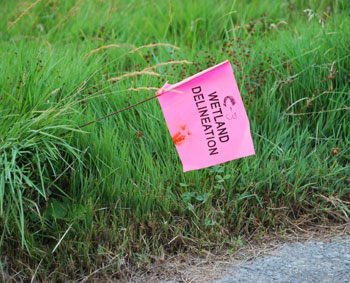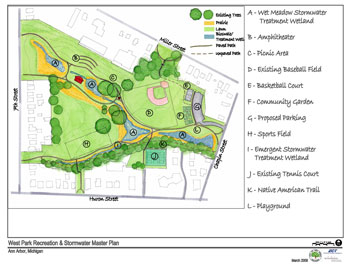West Park Renovations Get Fast-Tracked

This is one of nine black willow trees in West Park slated for removal as part of a planned park renovation. The historic bandshell, seen in the background, will stay. (Photo by the writer.)
The Chronicle last heard an update on improvements planned for West Park about a year ago, at a community meeting led by Amy Kuras, a landscape architect with the city. Kuras was also on hand at Tuesday’s meeting of the Ann Arbor Park Advisory Commission – this time, to report that the project is being fast-tracked in hopes of getting federal stimulus funding.
In addition to being briefed on West Park, PAC commissioners got an update on the Ann Arbor Skatepark project. Trevor Staples, chair of the Skatepark Action Committee, reported on fundraising progress and said he’d be back at a later date to ask for financial support from the city. He also gave some details on an Oct. 18 design workshop that will be open to the public.
And Scott Rosencrans won an election – more on all of this after the break.
West Park Renovations
Amy Kuras of the city’s parks & recreation staff prefaced her update to PAC by describing the outcome of three public meetings held last year focused on the West Park area. Three main priorities were voiced by residents: 1) deal with flooding in the park, 2) improve access and 3) preserve the recreational amenities.
On Tuesday, Kuras told commissioners that all of the current features of the park – including the basketball and tennis courts, baseball field, historic bandshell and pergola – will remain, though some locations might be altered. For example, they’ll move the basketball court out of the floodway, and reconfigure the parking lot. A boardwalk going through a wetland area will be added as part of the revamped network of paths. Tiered concrete retention walls for seating will be added to the hill facing the bandshell, and deteriorating steps coming down into the park from Huron Street will be replaced. There are also plans to reintroduce an historic Indian trail, which runs along the south side of the park.
The city has contracted with two firms for the project: Beckett & Raeder is handling engineering and landscape architecture issues, and Environmental Consulting & Technology (ECT) takes the lead on stormwater management.
At Tuesday’s PAC meeting, Andrea Kline of ECT gave a report on the stormwater management part of the project. An Allen Creek tributary, called the West Park/Miller branch, used to run though the park but was diverted into large underground storm sewer pipes in the 1920s. Though the storm sewer pipes will remain unchanged, the current project will build bioswales – shallow excavated areas filled with native vegetation – that roughly follow the course of the tributary.
The bioswales will widen into detention basins designed to catch stormwater. The deepest one, on the park’s northwest side, will hold up to three feet of water during heavy rains. Water will be contained for about a day as it slowly drains into the ground. Basins on the south side will have about two feet of water permanently, designed to support wetland habitat and plants. The bioswales and basins will be surrounded by buffers of native grasses and wildflowers found in wetland areas. Some of the wetland areas are already marked, in preparation for the project.

These pink flags in West Park indicate wetland areas where bioswales will be built to manage stormwater. (Photo by the writer.)
Kline said the bioswales and accompanying landscaping work will divert water from pathways in the park, which now are frequently flooded with water. In addition, some paths will be relocated to avoid the most problematic flooding areas.
The project also aims to improve the quality of water as it flows through the park. The city will be installing large swirl concentrators at two locations on the west side of the park. Storm water that flows through these underground concrete devices is swirled in a cylindrical chamber, filtering out a large amount of sediment, oil, grease and other contaminants.
The filtering effect from the entire water management system, including the bioswales, could remove as much as 60% of phosphorus and 70% of E.coli from the water before it leaves the park, according to a city report.
Because the Allen Creek is under the jurisdiction of Washtenaw County’s Office of the Water Resources Commissioner, the city is working with that department on this project. It’s the work on water management that makes the project eligible for federal stimulus funding, awarded through a Nonpoint Source Program administered by the Michigan Department of Environmental Quality. Nonpoint source pollution refers to pollution that comes from many different, diffuse sources – like rainwater runoff that contains lawn fertilizers or motor oil. (An example of something that’s not a nonpoint source pollution would be the Pall Life Sciences 1,4 dioxane plume in the city’s groundwater.)
This phase of the West Park project is estimated to cost $3.54 million. A later phase would include building restrooms and a playground.
If funds are awarded, work on the project will likely begin next summer. The work will entail cutting down nine of the large black willow trees (Salix nigra) in the area near the bandshell. Kline said those trees are well past their prime, and are located in the lowest part of the park, where flooding is a problem. They worked hard to preserve the oaks in the park, Kline said, but it wasn’t possible to save the willows. The city plans to take cuttings from the willows and possibly ask Wildtype, a native plant nursery in Mason, Mich. to nurture them into a size that eventually can be replanted in the park.
Skatepark Update
At Tuesday’s PAC meeting, commissioners also got an update from Trevor Staples, chair of the Ann Arbor Skatepark Action Committee. He reported that the group is focusing on two main areas: design and fundraising.
Wally Hollyday, a skatepark designer with a national reputation, will be leading a workshop on Oct. 18 to get community input on the park’s design. The meeting, which is open to the public, begins at 2 p.m. at the Slauson Middle School cafeteria, 1019 W. Washington St. There will also be a tour of the proposed site – at the northwest corner of Veterans Memorial Park – before the workshop, starting at 1:30 p.m.

Trevor Staples, chair of the Ann Arbor Skatepark Action Committee, and Jim Reische, the committee's fundraising co-chair, update PAC on the project. (Photo by the writer.)
At the workshop, Hollyday will present illustrations of different skateparks that he has designed, and get feedback about what people attending the session like or don’t like. Based on that feedback, he’ll sketch out some preliminary designs for the Ann Arbor skatepark, Staples said.
Having a design in hand can be a very persuasive tool for raising money from private donors, said Jim Reische, fundraising co-chair for the skatepark committee.
He outlined two fundraising approaches they’re using for this project. They’ve conducted a broad grassroots campaign that has included free “skate jams” for the public, a float in the July 4th parade, T-shirt sales at the Ann Arbor art fairs, and a Skate Art Show in May that drew 400 people and raised nearly $9,000. In addition, the skatepark group is working to secure large donations from individuals, Reische said, “to move us toward our financial goal in a big way.”
What is that goal? The group hopes to raise $1 million – including $800,000 for design and construction of the skatepark, and $200,000 to seed an endowment for ongoing maintenance. The Ann Arbor Area Community Foundation, which is serving as fiscal sponsor for this effort, sets aside 10% of all contributions toward the endowment. To date, they’ve raised close to $17,000 for the community foundation fund, mostly from small gifts, Reische said.
Staples said they’d be seeking public funds as well. The Washtenaw County parks department has expressed some interest in helping fund the project, he said, adding that he hoped to see a city/county partnership evolve. He didn’t have any specific funding requests for PAC, but said he just wanted to “dip our toes in that water.”
PAC chair Linda Berauer told Staples that there were already models for city/county collaboration, citing the Swift Run Dog Park as an example.
In response to a query from commissioner Scott Rosencrans, Reische said they’d identified some giving levels and naming opportunities, but hadn’t finalized details yet – the city still needs to set a policy for that. Jeff Straw, the city’s deputy parks & rec manager, said city staff were in reviewing a naming policy, which would have to be approved by city council. Tentatively, the skatepark committee has designated $400,000 as the level to name the skatepark, with a range of smaller amounts, down to $500 for tiles.
Rosencrans also asked if there were any upcoming fundraisers that PAC could help publicize. Staples said they’ll be doing fewer events – he noted that in a couple of weeks he’ll be returning to the classroom as a third-grade teacher, and the thought of putting together a fundraiser “sort of wigs me out.” The next event will be the Oct. 18 design workshop, followed in February by an indoor skate jam, likely in conjunction with Zingerman’s.
PAC Officer Elections
Linda Berauer, PAC’s chair, is ending her tenure on the commission, as is Brigit Macomber – both have served two, three-year terms. So neither of them were in the running for PAC offices – and, it turns out, not many others were, either. During Tuesday’s meeting, John Lawter nominated Scott Rosencrans as chair – he was the only nomination. Lawter currently serves as vice-chair, and was nominated for that position again, with no one else competing.
The commission recently changed its by-laws to allow secret ballots for the election of officers. Berauer noted that “it seems kind of silly” to vote secretly when the election wasn’t contested – but slips of paper were passed around anyway, and everyone dutifully wrote down the names of the candidates.
After Jeff Straw, the city’s deputy parks and rec manager, reported the results, someone quipped: “No recount?” It was an allusion to the recount of the Democratic primary election for Ward 3 city council, which is scheduled for next week.






Just an FYI–the Indian Trail in West Park has already begun renovations. Two classes of students, one at Community High and one at Ann Arbor Open, worked on the project this past year with the Parks department and local Native Americans. In the Spring they did a big brush-clearing and trail restoration and now it is possible to walk the trail!
Please inform Miller Ave. long time home owners of next meeting with regards to doing away with glorious black willow trees in West Park, I have been looking at them for forty six years — Willows are a beautiful thing — The root of a willow tree absorb water more than any other tree. — Barbara E.O’Donnell
keep the willows…